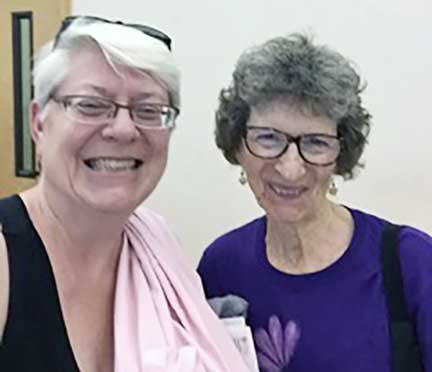Intentional Community: An Authentic Sign of Hope (Proposal 10)
Posted on November 1, 2019, by Jean East CoL

A conference in Hudson, N.Y., provided signs of hope through the topic “Diversity and Inclusion in Intentional Communities.” Beth Blissman and I attended the conference this past July. The conference included more than 50 sessions, tours of local communities, community meals, movies and plays.
Beth and I attended different sessions that were applicable to ideas in response to Assembly 2018 Proposal 10 (exploration of the feasibility of sustainable homes and intergenerational spiritually based communities as part of the future of Loretto mission). Their focus was on how to blend community life and service/mission in today’s world. Many types of intentional communities were represented: eco-villages, Camphill communities, sustainable communities, kibbutz communities and more.
Many types of intentional communities were represented: eco-villages, Camphill communities, sustainable communities, kibbutz communities and more.
Located in the rural communities surrounding Hudson are four Camphill communities. Camphill is a movement and initiative for social change, where community is the basic principle and service is a part of community life. Camphill communities are residential communities that provide support for the education, employment and daily lives of adults and children with intellectual challenges and special needs. There are more than 100 Camphill communities in more than 20 countries across the world. The Camphill movement, which is based on the philosophy of Rudolf Steiner (1861-1925), began in Aberdeen, Scotland, in June 1940. It bears similarity to the more widely known efforts of Jean Vanier and the L’arche communities. I presented with four others from Angelica Village, an intentional community in Denver that includes refugees, immigrants and formerly homeless families. Angelica Village is supported by the Loretto Special Needs Social Change Fund and has a Loretto Volunteer this year, Becca Krasky. The presentation was recorded via Facebook Live on the Loretto at the UN Facebook page and is available here: https://www.facebook.com/LorettoUN/videos/510546019682597/ or by request from [email protected].
We learned much from the conference: how to start communities, how to sustain communities, how to combine community and service, how to build relationships and recognize that intentional community can be both lifegiving and a place of pain and reality, how to set up inclusive systems of governance and how to think about inclusion and exclusion.
‘Building intentional communities is a spiritual process and teaches us how to be in relationships through healing and reconciliation.’
As I reflect on this experience, “For me, the strongest messages were how important it is for communities to exist in today’s world to disrupt systems of harm. Communities are a natural way to make the ‘invisible people visible.’ Building intentional communities is a spiritual process and teaches us how to be in relationships through healing and reconciliation.”
‘The intentional community movement offers us additional options for meeting our needs, such as do-it-yourself (DIY) options, barter, sharing items (thereby reducing the individual burden), reusing/recycling within a community and redefining needs (vs. wants).’
Beth reflects, “For me, the key lessons learned at the ICSA related to how we define economics. I was raised to associate the term economics with money, finance and tools used by people to move money around in ways that made more money over the long term. However, the term economics actually means something closer to managing how we get our daily needs met. Therefore, economics is more about getting our needs met than dollars and cents. The intentional community movement offers us additional options for meeting our needs, such as do-it-yourself (DIY) options, barter, sharing items (thereby reducing the individual burden), reusing/recycling within a community and redefining needs (vs. wants).”
Yana Ludwig, author of Together Resilient: Building Community in the Age of Climate Disruption, who participated in the conference and has presented to Loretto in Denver, writes, “… the potential of intentional communities lies largely in one of their fundamental characteristics: We can try out stuff that is radically different than the mainstream” (p.12).
Work on Assembly’s Proposal 10 is progressing well.
